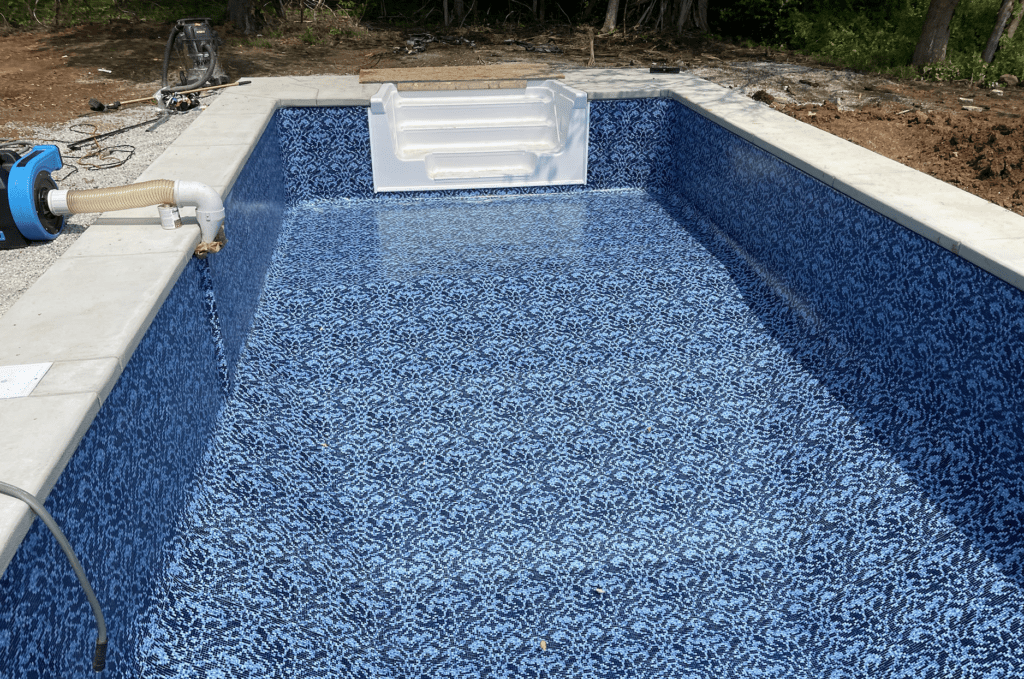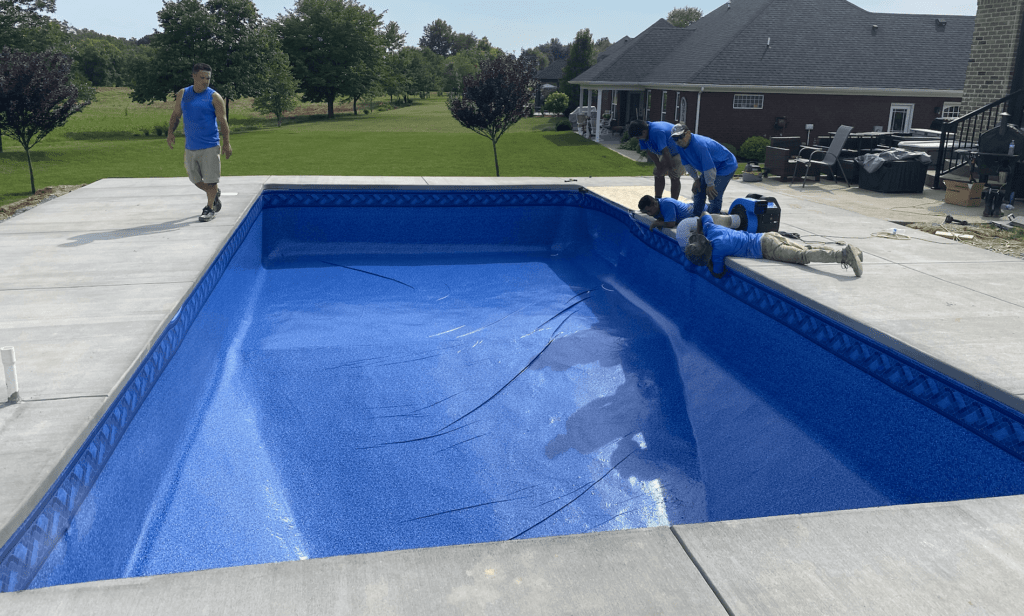The pool industry is filled with terms that new pool owners haven’t heard of.
One of these terms is “pool liners”, which means the skin of your pool or how it looks from above.
Most of these pool liners are “vinyl liners”, which is the material you feel if you’ve ever ran your foot across the bottom of most pools.
The great part about pool installation, coming from one of the biggest pool installation companies in Louisville, is that you can choose what’s best for your pool.
This gives you the chance to sparkle up your pool or keep things basic.
Whether you are installing a new pool or replacing an existing liner here are some key factors to consider that will help you make the best choice:
Material quality is super important.
Pool liners come in two materials: vinyl and fiberglass.
Vinyl liners are popular due to their affordability and versatility, and this is what we typically recommend for our customers.
They’re available in a wide range of colors and patterns and can be custom-fitted to any pool shape and size.
Fiberglass liners, on the other hand, are more durable and require less maintenance, but they are typically more expensive and offer fewer design options.
Vinyl liners are favored for their soft touch and flexibility, which allows them to fit into any unique pool shape without the risk of cracking.
For example, a pool owner in Louisville might choose a vinyl liner for a custom aqua-technics pool, which requires a flexible material that can adapt to its intricate curves and contours.
You should be aware of your liner’s thickness and durability.
The thickness of the pool liner is a major determinant of its durability.
Liners generally range from 20 to 30 mils (a mil is one-thousandth of an inch).
Thicker liners are more resistant to punctures and general wear and tear, making them a good choice for pools that see a lot of use or are in areas with rougher conditions.
One of the most common reasons we’re called out to replace vinyl liners is because the previous installation contractors made the liners too thin – resulting in early damage.
You should think about the activity level of your pool and the local climate when choosing the thickness.
For example, a family in Louisville with young children and pets might opt for a 30 mil vinyl liner, which offers better resistance to potential punctures from toys and claws.
On the other hand, a quieter household might choose a 20 mil liner for a less frequented pool, providing sufficient protection and cost savings.
The thicker the liner, the more resistant it is to external forces and general degradation, ensuring the pool’s aesthetic and structural integrity over longer periods.
You should choose the pattern and color that looks best for your pool.

There’s a big misconception that every pool floor looks the same.
Typical, that’s a light-blue color. If you think of a typical American backyard pool, that’s what comes to mind right?
But the color and pattern of the liner dramatically affects the look of your pool.
For example, darker colors make the pool water appear deeper, while lighter colors can make the water look more luminous.
Patterns can mimic the look of tiles or stones, adding a unique aesthetic to your pool.
When selecting a color or pattern, consider the overall landscape and theme of your outdoor area. This depends on your home’s space, but generally you can apply the same fashion rules for pools.
Have you ever heard that wearing black makes you look slimmer?
It’s very similar with blue making your pool look bigger, hence the popularity of the color.
A smaller pool in your backyard benefits from a lighter blue pattern to make the water appear more expansive and inviting.
Another homeowner might select a dark liner with a mosaic tile pattern, lending a classic, more sophisticated look that complements a formal garden setting.
The visual effect of the liner significantly affects the ambiance of the pool area and can be tailored to match the homeowner’s aesthetic desires.
If your pool is in a wide open space – lighter colors are generally recommended from us.
You should know about the liner’s warranty before installation.
Did you know that the average life of a pool liner in a medium size pool is 10 years?
Now 10 years sounds like a long time but the problem is that inground pools can be a long term investment, meaning that at some point, you’re going to want to have them replaced.
Always check the warranty offered with the pool liner.
A good pool liner warranty can provide peace of mind and protect your investment.
Generally, longer warranties are associated with higher quality liners, since the contractors don’t want to have to return next year to replace them at their expense.
Be sure to understand what the warranty covers and any conditions that may void it, that way you don’t have to worry about unexpected costs.
Get info on all of your options before making your final decision.

The most important thing when choosing your pool liners is that you like the design and it’s durable.
The design you choose is going to be with you for years, if not over a decade and you want to make sure it looks great.
This is an extension of your home as an outdoor living space.
Before paying someone to replace or install your pool liner, make sure you have all of the facts available before pulling the trigger.
If you’re in the Louisville area and have questions about vinyl pool liners, please feel free to call us at (502) 308-4555.


